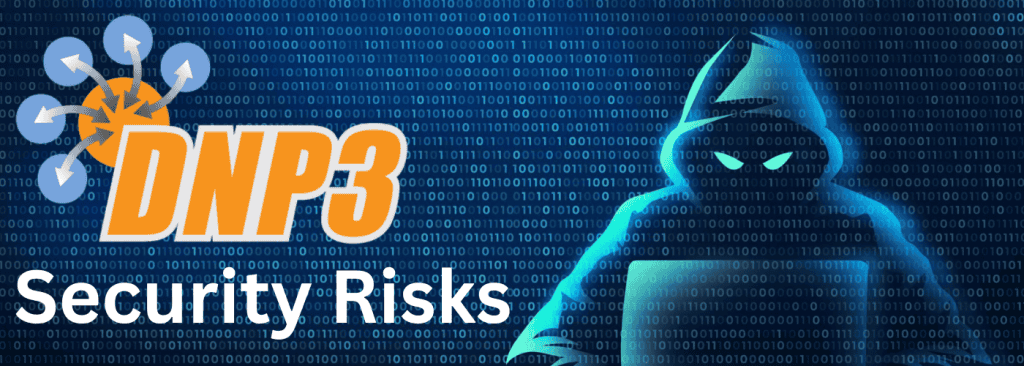DNP3 Security Risks
DNP3 Cybersecurity Risks
DNP3 (Distributed Network Protocol version 3) is a widely used communications protocol for industrial control systems (ICS) and supervisory control and data acquisition (SCADA) systems. While DNP3 provides several features designed to enhance the reliability and efficiency of communication between control devices and data acquisition systems, it also poses certain security risks, especially when deployed in critical infrastructure environments. Some of the key security risks associated with the DNP3 protocol include:
- Lack of Authentication: Traditional versions of DNP3 lack robust authentication mechanisms, making it susceptible to unauthorized access and potential tampering of data. Without proper authentication, malicious actors may impersonate legitimate devices or inject false commands into the network, leading to disruptions or sabotage of industrial processes.
- Limited Encryption: While newer versions of the DNP3 protocol include support for encryption, many legacy implementations still rely on unencrypted communication channels, leaving data transmitted over the network vulnerable to interception and eavesdropping. Even in cases where encryption is used, weak cryptographic algorithms or misconfigured encryption parameters may weaken the overall security of the communication channel.
- Insecure Command and Control Messages: DNP3 allows control commands to be transmitted over the network to remotely manage and manipulate industrial devices. However, if these command and control messages are not properly secured, they may be intercepted or modified by attackers to manipulate critical infrastructure systems, disrupt operations, or cause physical damage to equipment.
- Lack of Integrity Protection: Without mechanisms to ensure the integrity of data transmitted over the network, DNP3 communications are susceptible to data tampering attacks. Malicious actors may modify data values, timestamps, or other parameters exchanged between control devices and SCADA systems, leading to inaccurate monitoring, control errors, or unsafe operating conditions.
- Denial-of-Service (DoS) Attacks: DNP3 implementations may be vulnerable to denial-of-service attacks, where attackers flood the network with excessive traffic or malformed packets, causing disruption or degradation of service. DoS attacks targeting DNP3 infrastructure can disrupt industrial processes, compromise system availability, and impact critical services.
- Legacy Compatibility Issues: Many industrial control systems still rely on legacy versions of the DNP3 protocol, which may lack modern security features and fail to address emerging threats. The challenge of maintaining backward compatibility with legacy equipment while ensuring adequate security measures poses a significant risk for organizations using DNP3 in critical infrastructure environments.
To mitigate these DNP3 security risks, organizations should implement best practices for securing DNP3 communications, such as deploying strong authentication mechanisms, encrypting sensitive data, ensuring the integrity of communication channels, and regularly updating and patching DNP3 software to address known vulnerabilities. Additionally, conducting thorough security assessments and implementing network segmentation and access controls can help reduce the exposure of DNP3 systems to potential cyber threats.
DNP3 Cyberattack Risk Analysis
A study was published in 2002 (“Risk Analysis of DNP3 Attacks”) that used some numerical methods to quantify the risks from different types of attacks. The attack types are summarized below:
| DNP3 Cyberattack | Description |
| Man in The Middle (MiTM) | The intentional placement of a malicious entity between two communication endpoints with the aim of intercepting and modifying their network traffic |
| Packet assembly | Generation of a packet that changes intended attributes |
| Injection | Insertion of the modified packet in the traffic stream |
| Master impersonation | DNP3 outstations will respond to any master station, including fake ones. The operations and behavior of a legitimate master is imitated by a malicious entity |
| Function code modification | Sending a function code to the outstation resulting in malicious operations including the full or partial restart of the outstation, initializing data, ceasing operations, and disabling the ability to send unsolicited messages |
| Nmap | Gathering intelligence regarding whether the targeted IP address belongs to a DNP3 outstation |
| Traffic delay (Replay) | The traffic to the targeted endpoint is being maliciously delayed obstructing regular communication |
The attack methods were then used to conduct the testing. Below is a summary of the attack, the intended purpose, and the approach used to initiate the cyberattack.
| DNP3 Cyberattack | Purpose | Attack Approach |
| Disable unsolicited messages | Prevent the outstation from sending unsolicited messages to the master. Prevents proactive alerting by the outstation. | Function Code Modification from a Malicious Master |
| Cold restart | Forces the outstation to perform a full restart and go through the self-check process resulting in being unresponsive to master requests | Restart request from a Malicious Master |
| Warm restart | Forces the outstation to restart DNP3 application only resulting in being unresponsive to master requests | Restart request from a Malicious Master |
| Slave discovery – link status | Determine if a specific IP address was used by a DNP3 outstation | Nmap script to 100 DNP3 data link addresses requesting link status |
| Slave discovery – request | Determine if a specific IP address was used by a DNP3 outstation | Nmap script to send requests to 100 DNP3 data link addresses seeking a response |
| Initialize data (reset data to default values) | Resets data in the outstation so updates sent to the master will not reflect actual status | MiTM packet interception, manipulation, and re-injection |
| Stop Application | Stops the outstation from running the DNP3 application making it unresponsive to requests from the master | MiTM packet interception, manipulation, and re-injection |
| Replay | Delay master requests packets by a random time period to obstruct regular DNP3 communication | MiTM approach to intercept, save, and delay packet transmission |
DNP3 Security – Reduce Cyber Risk, Protect ICS/OT Devices from Cyberattack
Authenticating all DNP3 devices and encrypting communication between them provides strong cybersecurity protection and reduces the attack surface. Since not all DNP3 stations are capable of using DNP3 Secure Authentication, a security overlay can be deployed that uses a NIST-compliant Zero Trust framework.
Veridify’s DOME platform provides authentication for securing any DNP3 device, with any software version, and across multiple manufacturers. In addition, it encrypts traffic between devices. DOME is based on a NIST-compliant, Zero Trust framework and is completely transparent to the end devices, so no changes to the network are needed.
Below is an example of DOME protecting multiple DNP3 outstations. There is a DOME Sentry at the Master Station and one or more DOME Sentry devices at each remote outstation. Existing DNP3 devices are untouched for security to be implemented.
Contact us to learn more DOME for securing DNP3 devices.
—
Blog Post Summary – All of our posts listed on one page back through 2019






